Benefits and Drawbacks of Derivatives in Business
VerifiedAdded on 2023/04/10
|19
|3660
|328
AI Summary
This article discusses the benefits and drawbacks of using derivatives in business for risk management and market access. It explains how derivatives can help hedge positions, determine asset prices, and provide access to underlying assets or markets. It also highlights the risks associated with derivatives, such as speculation and counterparty risks.
Contribute Materials
Your contribution can guide someone’s learning journey. Share your
documents today.
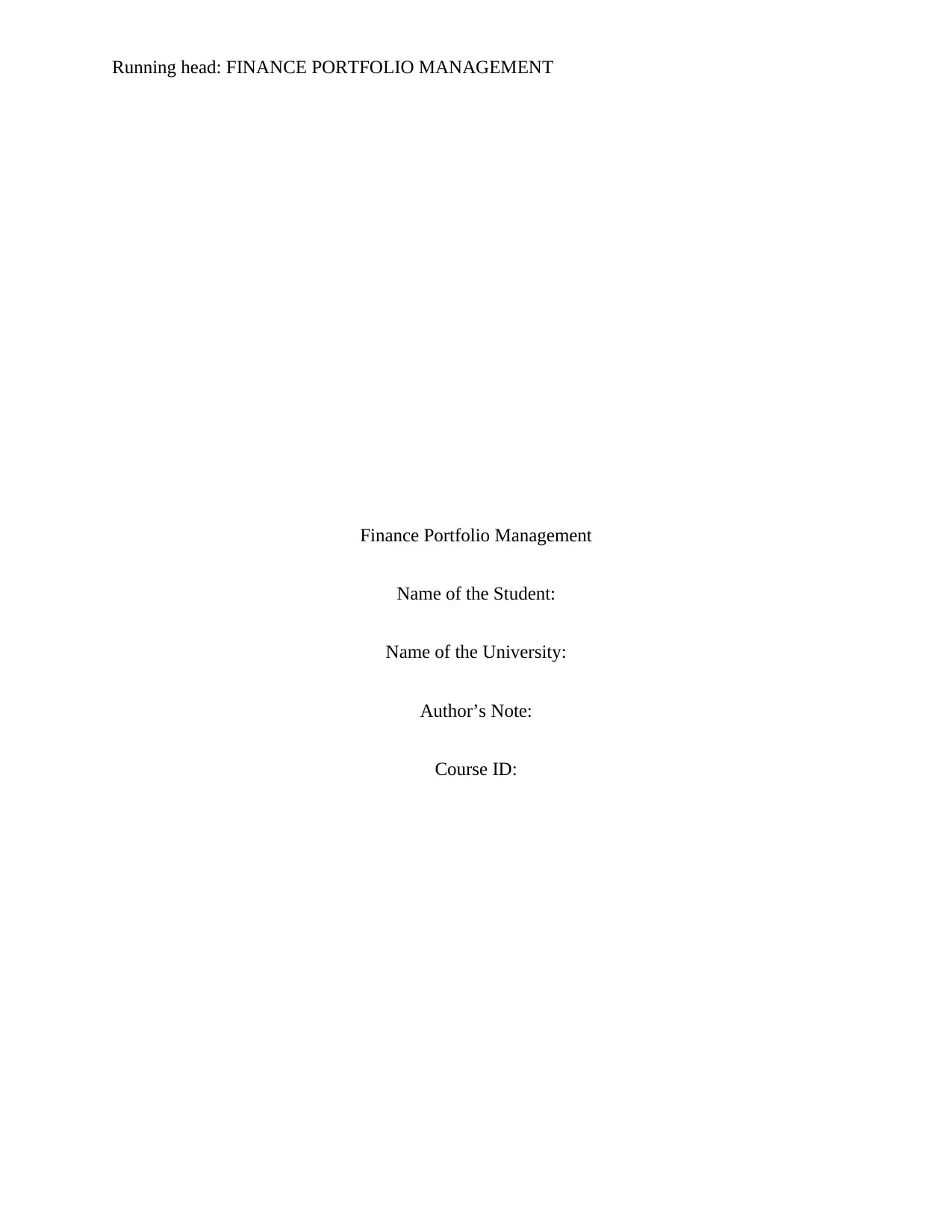
Running head: FINANCE PORTFOLIO MANAGEMENT
Finance Portfolio Management
Name of the Student:
Name of the University:
Author’s Note:
Course ID:
Finance Portfolio Management
Name of the Student:
Name of the University:
Author’s Note:
Course ID:
Secure Best Marks with AI Grader
Need help grading? Try our AI Grader for instant feedback on your assignments.

1FINANCE PORTFOLIO MANAGEMENT
Table of Contents
Answer to question 1.......................................................................................................................3
Answer to Question 3:.....................................................................................................................8
Answer to Question 4....................................................................................................................10
Answer to Question 5:...................................................................................................................13
References:....................................................................................................................................16
Table of Contents
Answer to question 1.......................................................................................................................3
Answer to Question 3:.....................................................................................................................8
Answer to Question 4....................................................................................................................10
Answer to Question 5:...................................................................................................................13
References:....................................................................................................................................16
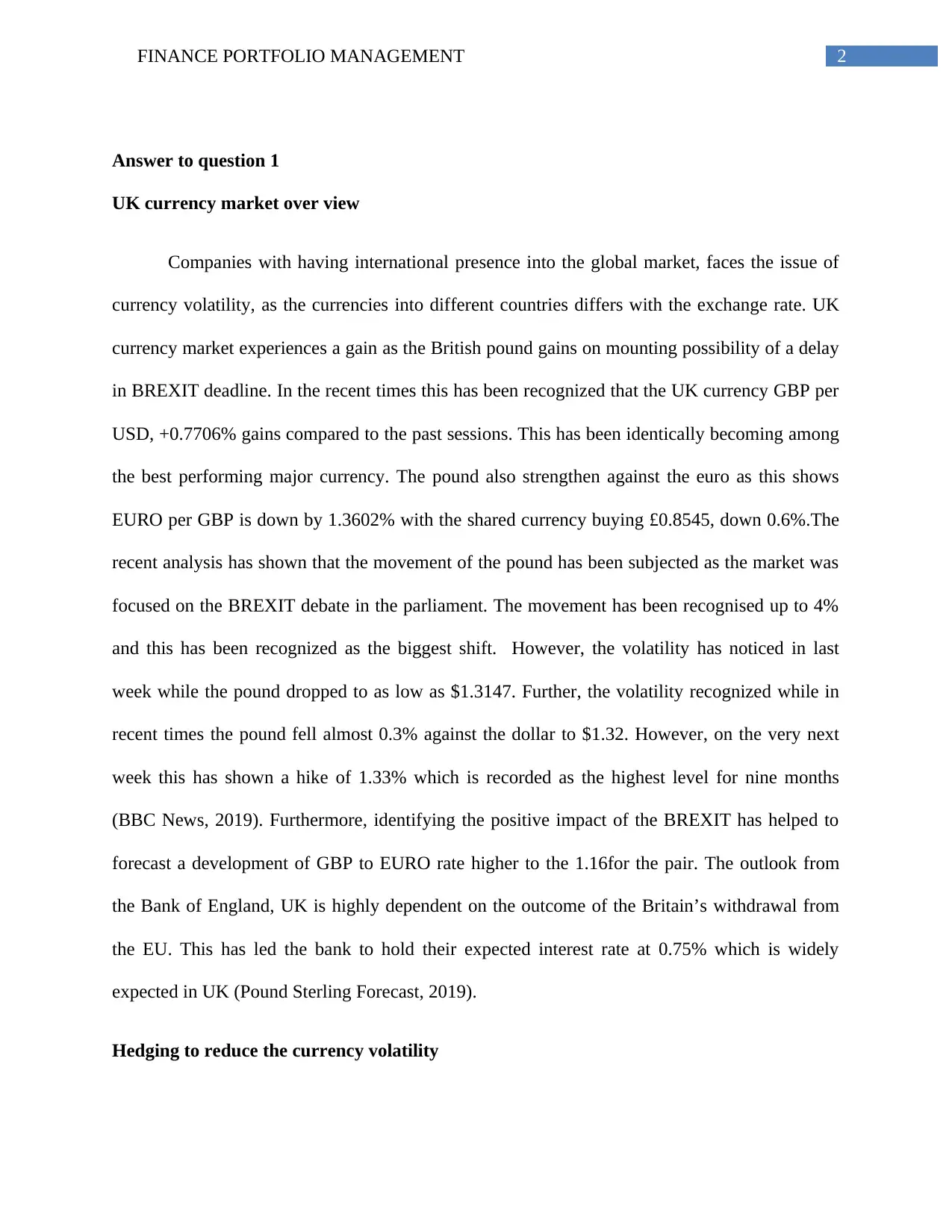
2FINANCE PORTFOLIO MANAGEMENT
Answer to question 1
UK currency market over view
Companies with having international presence into the global market, faces the issue of
currency volatility, as the currencies into different countries differs with the exchange rate. UK
currency market experiences a gain as the British pound gains on mounting possibility of a delay
in BREXIT deadline. In the recent times this has been recognized that the UK currency GBP per
USD, +0.7706% gains compared to the past sessions. This has been identically becoming among
the best performing major currency. The pound also strengthen against the euro as this shows
EURO per GBP is down by 1.3602% with the shared currency buying £0.8545, down 0.6%.The
recent analysis has shown that the movement of the pound has been subjected as the market was
focused on the BREXIT debate in the parliament. The movement has been recognised up to 4%
and this has been recognized as the biggest shift. However, the volatility has noticed in last
week while the pound dropped to as low as $1.3147. Further, the volatility recognized while in
recent times the pound fell almost 0.3% against the dollar to $1.32. However, on the very next
week this has shown a hike of 1.33% which is recorded as the highest level for nine months
(BBC News, 2019). Furthermore, identifying the positive impact of the BREXIT has helped to
forecast a development of GBP to EURO rate higher to the 1.16for the pair. The outlook from
the Bank of England, UK is highly dependent on the outcome of the Britain’s withdrawal from
the EU. This has led the bank to hold their expected interest rate at 0.75% which is widely
expected in UK (Pound Sterling Forecast, 2019).
Hedging to reduce the currency volatility
Answer to question 1
UK currency market over view
Companies with having international presence into the global market, faces the issue of
currency volatility, as the currencies into different countries differs with the exchange rate. UK
currency market experiences a gain as the British pound gains on mounting possibility of a delay
in BREXIT deadline. In the recent times this has been recognized that the UK currency GBP per
USD, +0.7706% gains compared to the past sessions. This has been identically becoming among
the best performing major currency. The pound also strengthen against the euro as this shows
EURO per GBP is down by 1.3602% with the shared currency buying £0.8545, down 0.6%.The
recent analysis has shown that the movement of the pound has been subjected as the market was
focused on the BREXIT debate in the parliament. The movement has been recognised up to 4%
and this has been recognized as the biggest shift. However, the volatility has noticed in last
week while the pound dropped to as low as $1.3147. Further, the volatility recognized while in
recent times the pound fell almost 0.3% against the dollar to $1.32. However, on the very next
week this has shown a hike of 1.33% which is recorded as the highest level for nine months
(BBC News, 2019). Furthermore, identifying the positive impact of the BREXIT has helped to
forecast a development of GBP to EURO rate higher to the 1.16for the pair. The outlook from
the Bank of England, UK is highly dependent on the outcome of the Britain’s withdrawal from
the EU. This has led the bank to hold their expected interest rate at 0.75% which is widely
expected in UK (Pound Sterling Forecast, 2019).
Hedging to reduce the currency volatility
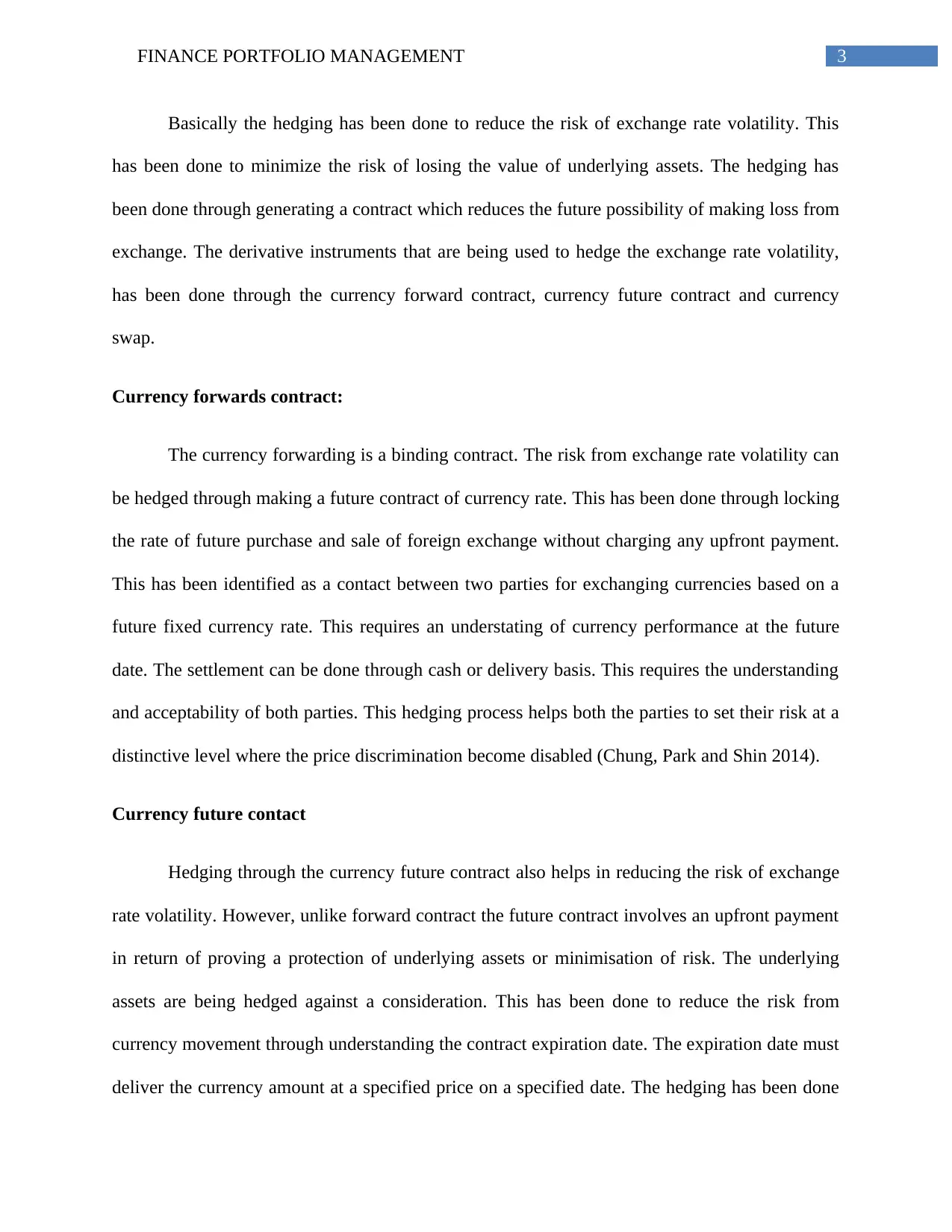
3FINANCE PORTFOLIO MANAGEMENT
Basically the hedging has been done to reduce the risk of exchange rate volatility. This
has been done to minimize the risk of losing the value of underlying assets. The hedging has
been done through generating a contract which reduces the future possibility of making loss from
exchange. The derivative instruments that are being used to hedge the exchange rate volatility,
has been done through the currency forward contract, currency future contract and currency
swap.
Currency forwards contract:
The currency forwarding is a binding contract. The risk from exchange rate volatility can
be hedged through making a future contract of currency rate. This has been done through locking
the rate of future purchase and sale of foreign exchange without charging any upfront payment.
This has been identified as a contact between two parties for exchanging currencies based on a
future fixed currency rate. This requires an understating of currency performance at the future
date. The settlement can be done through cash or delivery basis. This requires the understanding
and acceptability of both parties. This hedging process helps both the parties to set their risk at a
distinctive level where the price discrimination become disabled (Chung, Park and Shin 2014).
Currency future contact
Hedging through the currency future contract also helps in reducing the risk of exchange
rate volatility. However, unlike forward contract the future contract involves an upfront payment
in return of proving a protection of underlying assets or minimisation of risk. The underlying
assets are being hedged against a consideration. This has been done to reduce the risk from
currency movement through understanding the contract expiration date. The expiration date must
deliver the currency amount at a specified price on a specified date. The hedging has been done
Basically the hedging has been done to reduce the risk of exchange rate volatility. This
has been done to minimize the risk of losing the value of underlying assets. The hedging has
been done through generating a contract which reduces the future possibility of making loss from
exchange. The derivative instruments that are being used to hedge the exchange rate volatility,
has been done through the currency forward contract, currency future contract and currency
swap.
Currency forwards contract:
The currency forwarding is a binding contract. The risk from exchange rate volatility can
be hedged through making a future contract of currency rate. This has been done through locking
the rate of future purchase and sale of foreign exchange without charging any upfront payment.
This has been identified as a contact between two parties for exchanging currencies based on a
future fixed currency rate. This requires an understating of currency performance at the future
date. The settlement can be done through cash or delivery basis. This requires the understanding
and acceptability of both parties. This hedging process helps both the parties to set their risk at a
distinctive level where the price discrimination become disabled (Chung, Park and Shin 2014).
Currency future contact
Hedging through the currency future contract also helps in reducing the risk of exchange
rate volatility. However, unlike forward contract the future contract involves an upfront payment
in return of proving a protection of underlying assets or minimisation of risk. The underlying
assets are being hedged against a consideration. This has been done to reduce the risk from
currency movement through understanding the contract expiration date. The expiration date must
deliver the currency amount at a specified price on a specified date. The hedging has been done
Secure Best Marks with AI Grader
Need help grading? Try our AI Grader for instant feedback on your assignments.
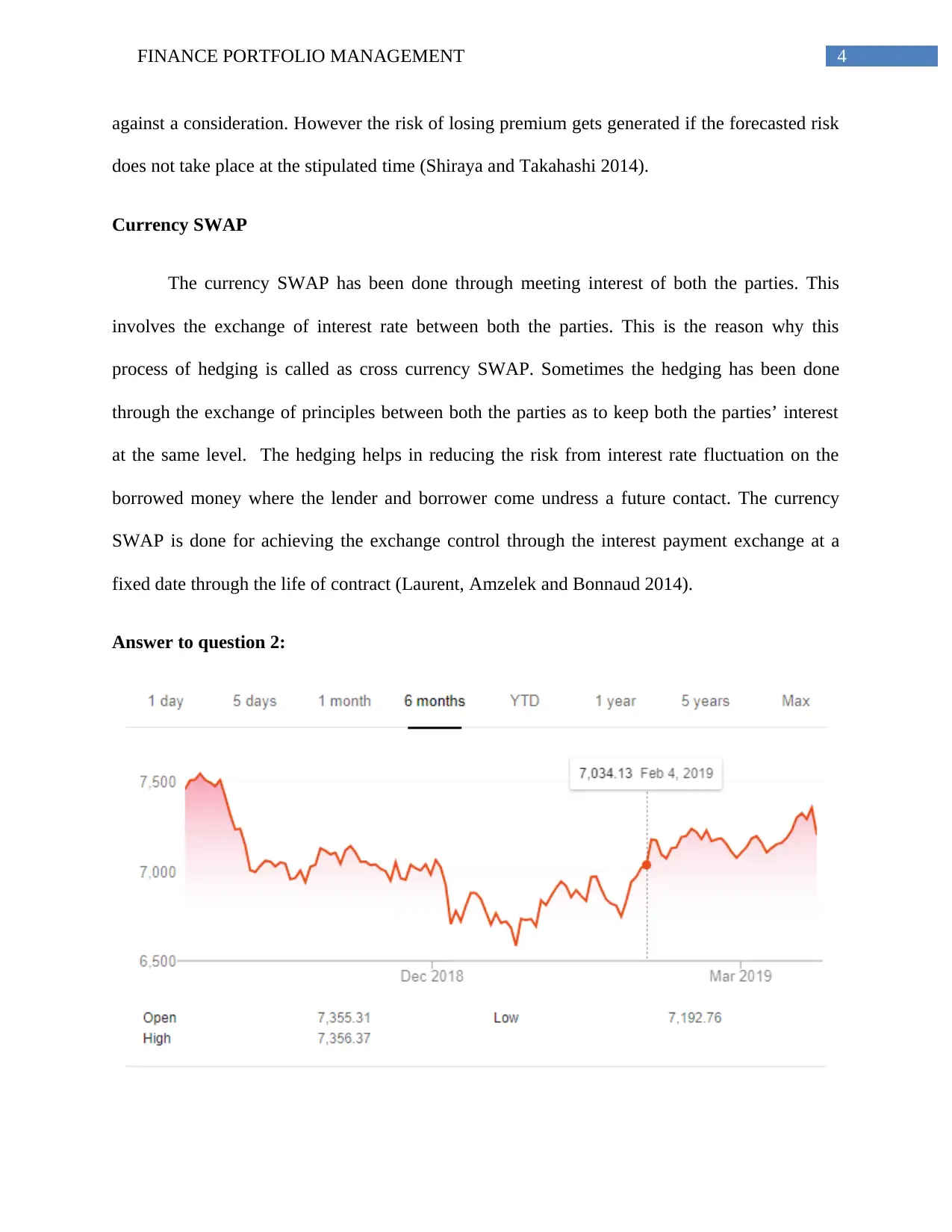
4FINANCE PORTFOLIO MANAGEMENT
against a consideration. However the risk of losing premium gets generated if the forecasted risk
does not take place at the stipulated time (Shiraya and Takahashi 2014).
Currency SWAP
The currency SWAP has been done through meeting interest of both the parties. This
involves the exchange of interest rate between both the parties. This is the reason why this
process of hedging is called as cross currency SWAP. Sometimes the hedging has been done
through the exchange of principles between both the parties as to keep both the parties’ interest
at the same level. The hedging helps in reducing the risk from interest rate fluctuation on the
borrowed money where the lender and borrower come undress a future contact. The currency
SWAP is done for achieving the exchange control through the interest payment exchange at a
fixed date through the life of contract (Laurent, Amzelek and Bonnaud 2014).
Answer to question 2:
against a consideration. However the risk of losing premium gets generated if the forecasted risk
does not take place at the stipulated time (Shiraya and Takahashi 2014).
Currency SWAP
The currency SWAP has been done through meeting interest of both the parties. This
involves the exchange of interest rate between both the parties. This is the reason why this
process of hedging is called as cross currency SWAP. Sometimes the hedging has been done
through the exchange of principles between both the parties as to keep both the parties’ interest
at the same level. The hedging helps in reducing the risk from interest rate fluctuation on the
borrowed money where the lender and borrower come undress a future contact. The currency
SWAP is done for achieving the exchange control through the interest payment exchange at a
fixed date through the life of contract (Laurent, Amzelek and Bonnaud 2014).
Answer to question 2:
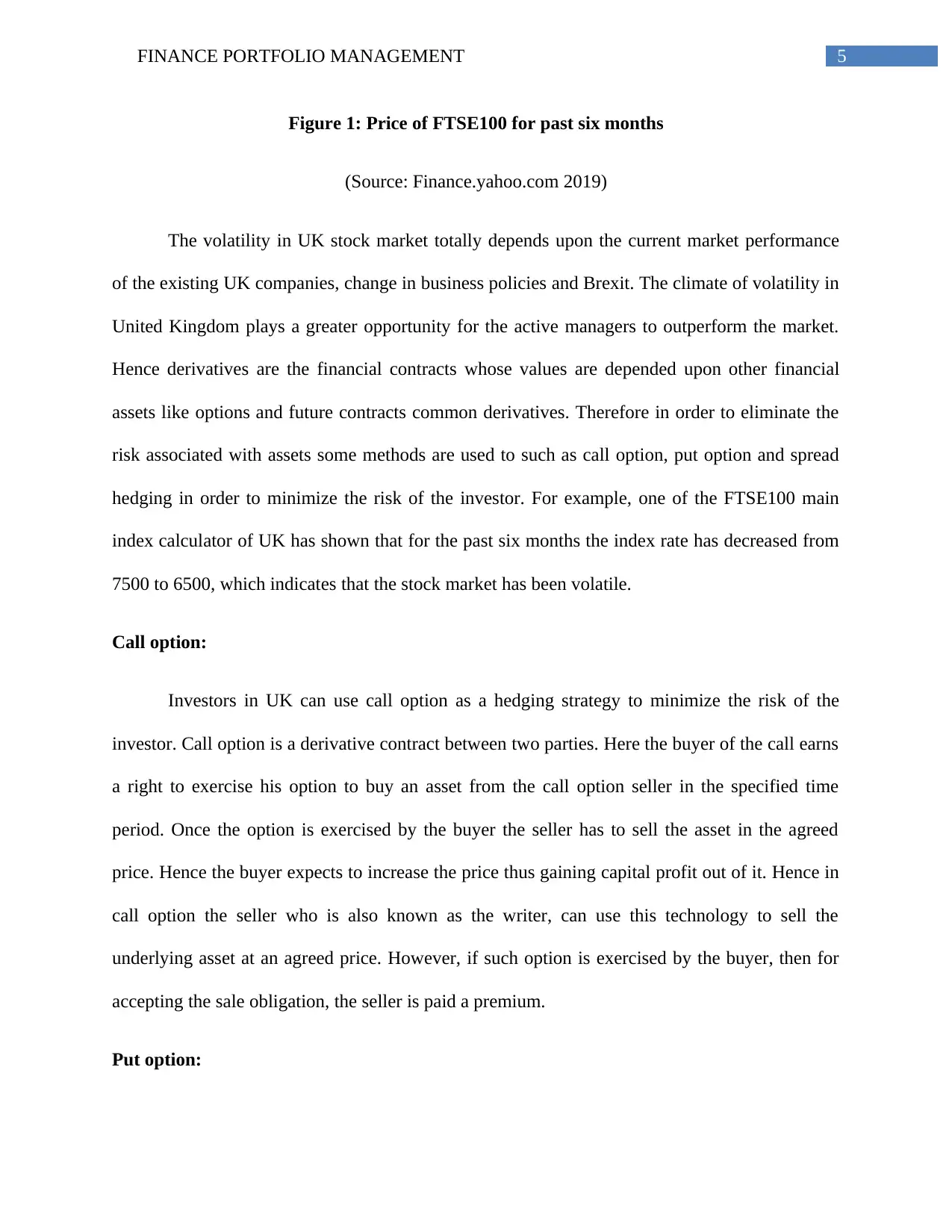
5FINANCE PORTFOLIO MANAGEMENT
Figure 1: Price of FTSE100 for past six months
(Source: Finance.yahoo.com 2019)
The volatility in UK stock market totally depends upon the current market performance
of the existing UK companies, change in business policies and Brexit. The climate of volatility in
United Kingdom plays a greater opportunity for the active managers to outperform the market.
Hence derivatives are the financial contracts whose values are depended upon other financial
assets like options and future contracts common derivatives. Therefore in order to eliminate the
risk associated with assets some methods are used to such as call option, put option and spread
hedging in order to minimize the risk of the investor. For example, one of the FTSE100 main
index calculator of UK has shown that for the past six months the index rate has decreased from
7500 to 6500, which indicates that the stock market has been volatile.
Call option:
Investors in UK can use call option as a hedging strategy to minimize the risk of the
investor. Call option is a derivative contract between two parties. Here the buyer of the call earns
a right to exercise his option to buy an asset from the call option seller in the specified time
period. Once the option is exercised by the buyer the seller has to sell the asset in the agreed
price. Hence the buyer expects to increase the price thus gaining capital profit out of it. Hence in
call option the seller who is also known as the writer, can use this technology to sell the
underlying asset at an agreed price. However, if such option is exercised by the buyer, then for
accepting the sale obligation, the seller is paid a premium.
Put option:
Figure 1: Price of FTSE100 for past six months
(Source: Finance.yahoo.com 2019)
The volatility in UK stock market totally depends upon the current market performance
of the existing UK companies, change in business policies and Brexit. The climate of volatility in
United Kingdom plays a greater opportunity for the active managers to outperform the market.
Hence derivatives are the financial contracts whose values are depended upon other financial
assets like options and future contracts common derivatives. Therefore in order to eliminate the
risk associated with assets some methods are used to such as call option, put option and spread
hedging in order to minimize the risk of the investor. For example, one of the FTSE100 main
index calculator of UK has shown that for the past six months the index rate has decreased from
7500 to 6500, which indicates that the stock market has been volatile.
Call option:
Investors in UK can use call option as a hedging strategy to minimize the risk of the
investor. Call option is a derivative contract between two parties. Here the buyer of the call earns
a right to exercise his option to buy an asset from the call option seller in the specified time
period. Once the option is exercised by the buyer the seller has to sell the asset in the agreed
price. Hence the buyer expects to increase the price thus gaining capital profit out of it. Hence in
call option the seller who is also known as the writer, can use this technology to sell the
underlying asset at an agreed price. However, if such option is exercised by the buyer, then for
accepting the sale obligation, the seller is paid a premium.
Put option:
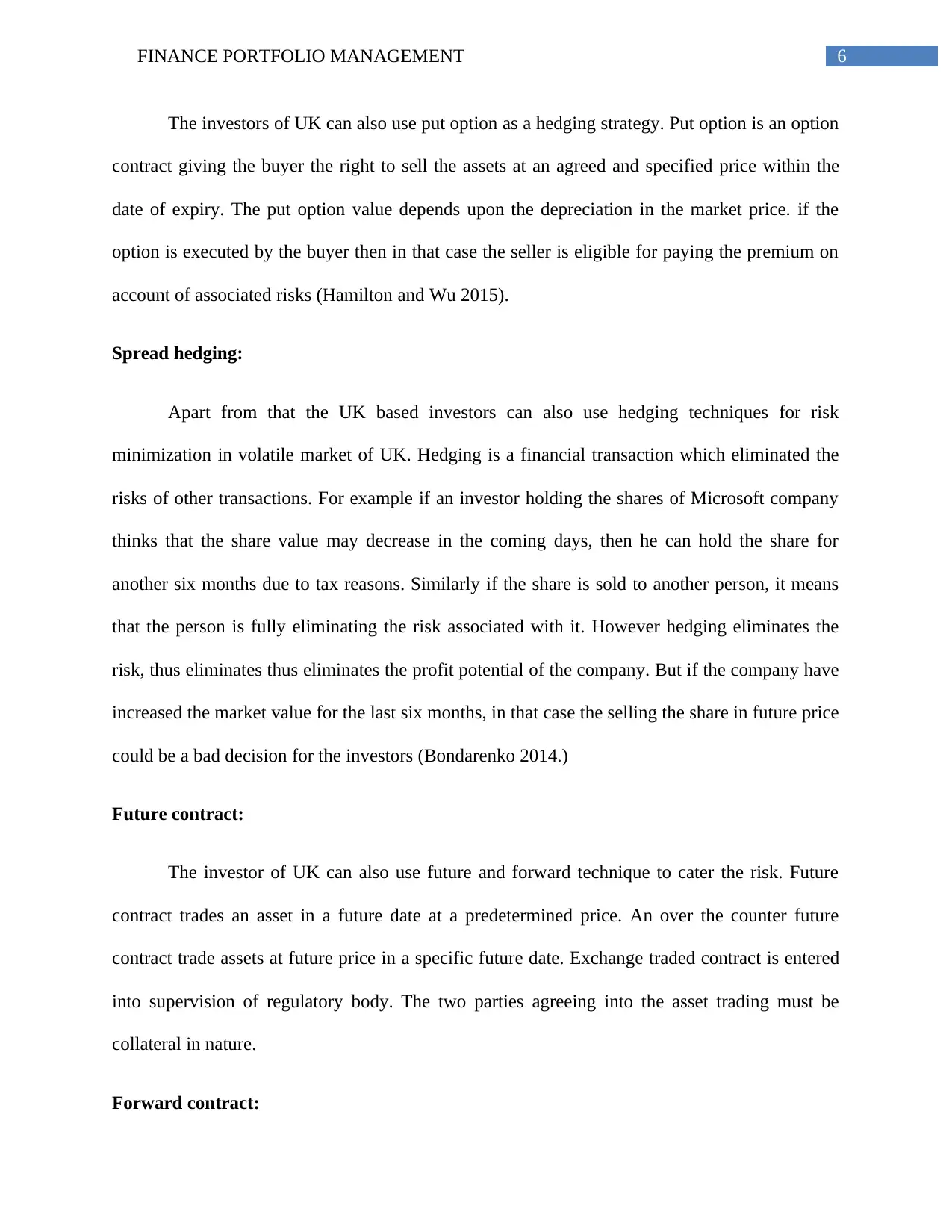
6FINANCE PORTFOLIO MANAGEMENT
The investors of UK can also use put option as a hedging strategy. Put option is an option
contract giving the buyer the right to sell the assets at an agreed and specified price within the
date of expiry. The put option value depends upon the depreciation in the market price. if the
option is executed by the buyer then in that case the seller is eligible for paying the premium on
account of associated risks (Hamilton and Wu 2015).
Spread hedging:
Apart from that the UK based investors can also use hedging techniques for risk
minimization in volatile market of UK. Hedging is a financial transaction which eliminated the
risks of other transactions. For example if an investor holding the shares of Microsoft company
thinks that the share value may decrease in the coming days, then he can hold the share for
another six months due to tax reasons. Similarly if the share is sold to another person, it means
that the person is fully eliminating the risk associated with it. However hedging eliminates the
risk, thus eliminates thus eliminates the profit potential of the company. But if the company have
increased the market value for the last six months, in that case the selling the share in future price
could be a bad decision for the investors (Bondarenko 2014.)
Future contract:
The investor of UK can also use future and forward technique to cater the risk. Future
contract trades an asset in a future date at a predetermined price. An over the counter future
contract trade assets at future price in a specific future date. Exchange traded contract is entered
into supervision of regulatory body. The two parties agreeing into the asset trading must be
collateral in nature.
Forward contract:
The investors of UK can also use put option as a hedging strategy. Put option is an option
contract giving the buyer the right to sell the assets at an agreed and specified price within the
date of expiry. The put option value depends upon the depreciation in the market price. if the
option is executed by the buyer then in that case the seller is eligible for paying the premium on
account of associated risks (Hamilton and Wu 2015).
Spread hedging:
Apart from that the UK based investors can also use hedging techniques for risk
minimization in volatile market of UK. Hedging is a financial transaction which eliminated the
risks of other transactions. For example if an investor holding the shares of Microsoft company
thinks that the share value may decrease in the coming days, then he can hold the share for
another six months due to tax reasons. Similarly if the share is sold to another person, it means
that the person is fully eliminating the risk associated with it. However hedging eliminates the
risk, thus eliminates thus eliminates the profit potential of the company. But if the company have
increased the market value for the last six months, in that case the selling the share in future price
could be a bad decision for the investors (Bondarenko 2014.)
Future contract:
The investor of UK can also use future and forward technique to cater the risk. Future
contract trades an asset in a future date at a predetermined price. An over the counter future
contract trade assets at future price in a specific future date. Exchange traded contract is entered
into supervision of regulatory body. The two parties agreeing into the asset trading must be
collateral in nature.
Forward contract:
Paraphrase This Document
Need a fresh take? Get an instant paraphrase of this document with our AI Paraphraser
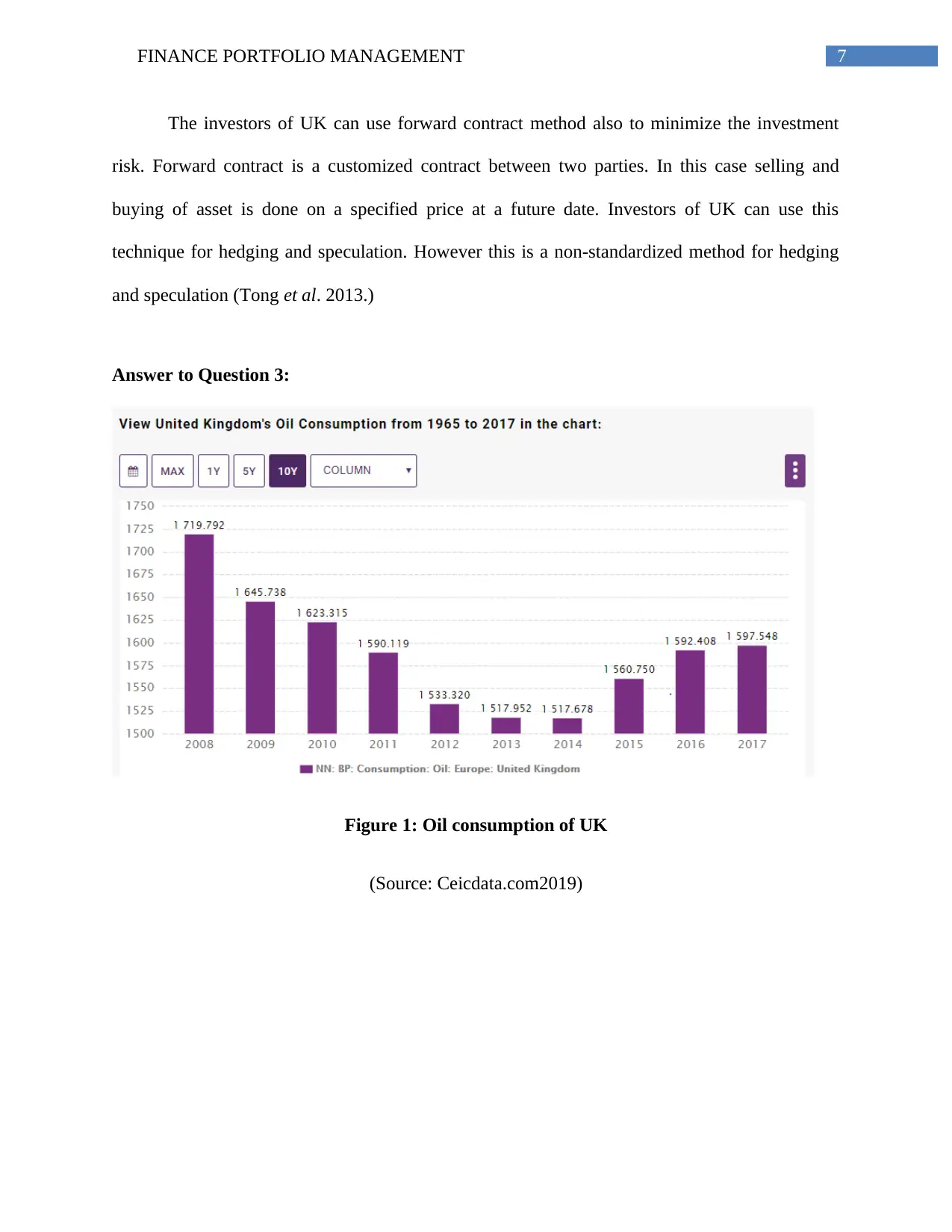
7FINANCE PORTFOLIO MANAGEMENT
The investors of UK can use forward contract method also to minimize the investment
risk. Forward contract is a customized contract between two parties. In this case selling and
buying of asset is done on a specified price at a future date. Investors of UK can use this
technique for hedging and speculation. However this is a non-standardized method for hedging
and speculation (Tong et al. 2013.)
Answer to Question 3:
Figure 1: Oil consumption of UK
(Source: Ceicdata.com2019)
The investors of UK can use forward contract method also to minimize the investment
risk. Forward contract is a customized contract between two parties. In this case selling and
buying of asset is done on a specified price at a future date. Investors of UK can use this
technique for hedging and speculation. However this is a non-standardized method for hedging
and speculation (Tong et al. 2013.)
Answer to Question 3:
Figure 1: Oil consumption of UK
(Source: Ceicdata.com2019)
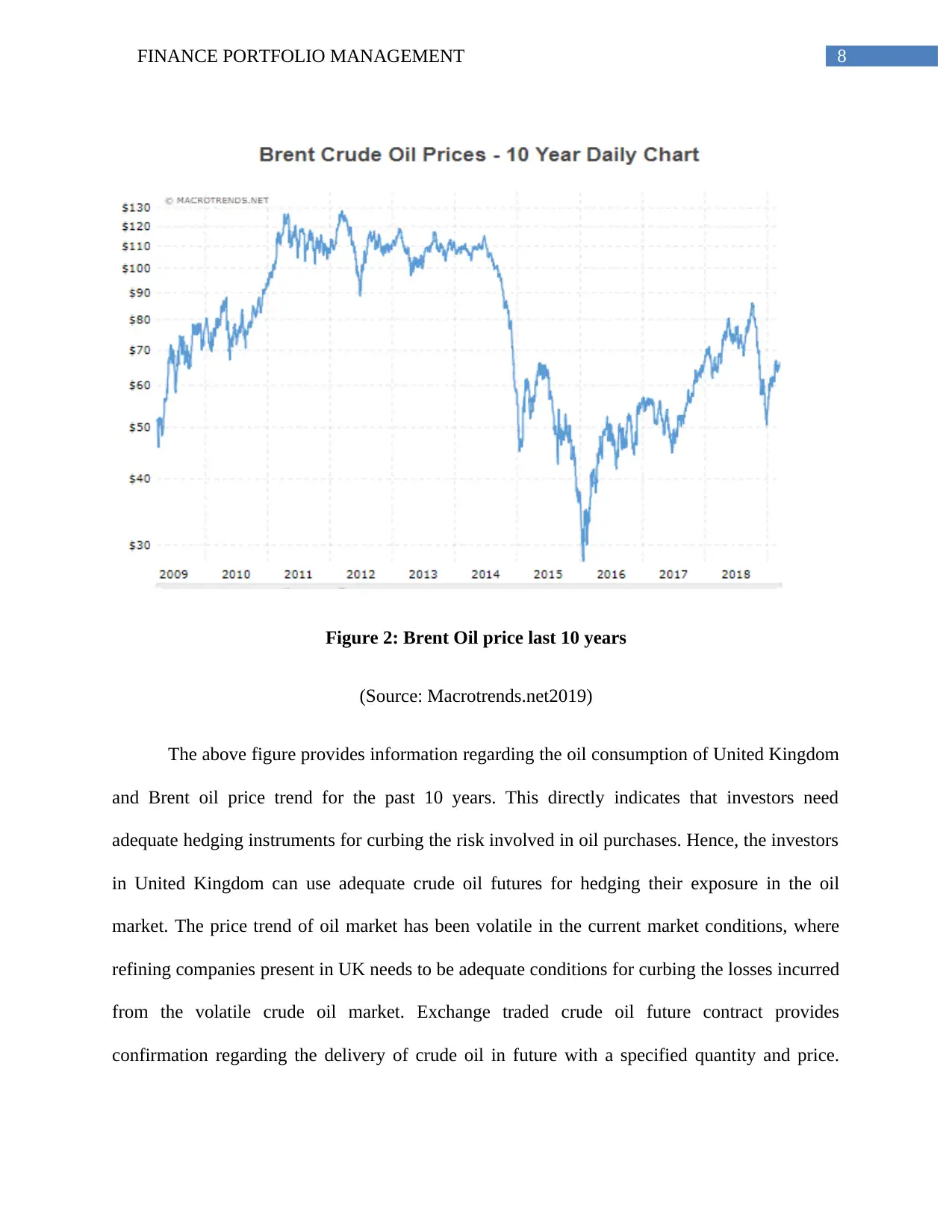
8FINANCE PORTFOLIO MANAGEMENT
Figure 2: Brent Oil price last 10 years
(Source: Macrotrends.net2019)
The above figure provides information regarding the oil consumption of United Kingdom
and Brent oil price trend for the past 10 years. This directly indicates that investors need
adequate hedging instruments for curbing the risk involved in oil purchases. Hence, the investors
in United Kingdom can use adequate crude oil futures for hedging their exposure in the oil
market. The price trend of oil market has been volatile in the current market conditions, where
refining companies present in UK needs to be adequate conditions for curbing the losses incurred
from the volatile crude oil market. Exchange traded crude oil future contract provides
confirmation regarding the delivery of crude oil in future with a specified quantity and price.
Figure 2: Brent Oil price last 10 years
(Source: Macrotrends.net2019)
The above figure provides information regarding the oil consumption of United Kingdom
and Brent oil price trend for the past 10 years. This directly indicates that investors need
adequate hedging instruments for curbing the risk involved in oil purchases. Hence, the investors
in United Kingdom can use adequate crude oil futures for hedging their exposure in the oil
market. The price trend of oil market has been volatile in the current market conditions, where
refining companies present in UK needs to be adequate conditions for curbing the losses incurred
from the volatile crude oil market. Exchange traded crude oil future contract provides
confirmation regarding the delivery of crude oil in future with a specified quantity and price.
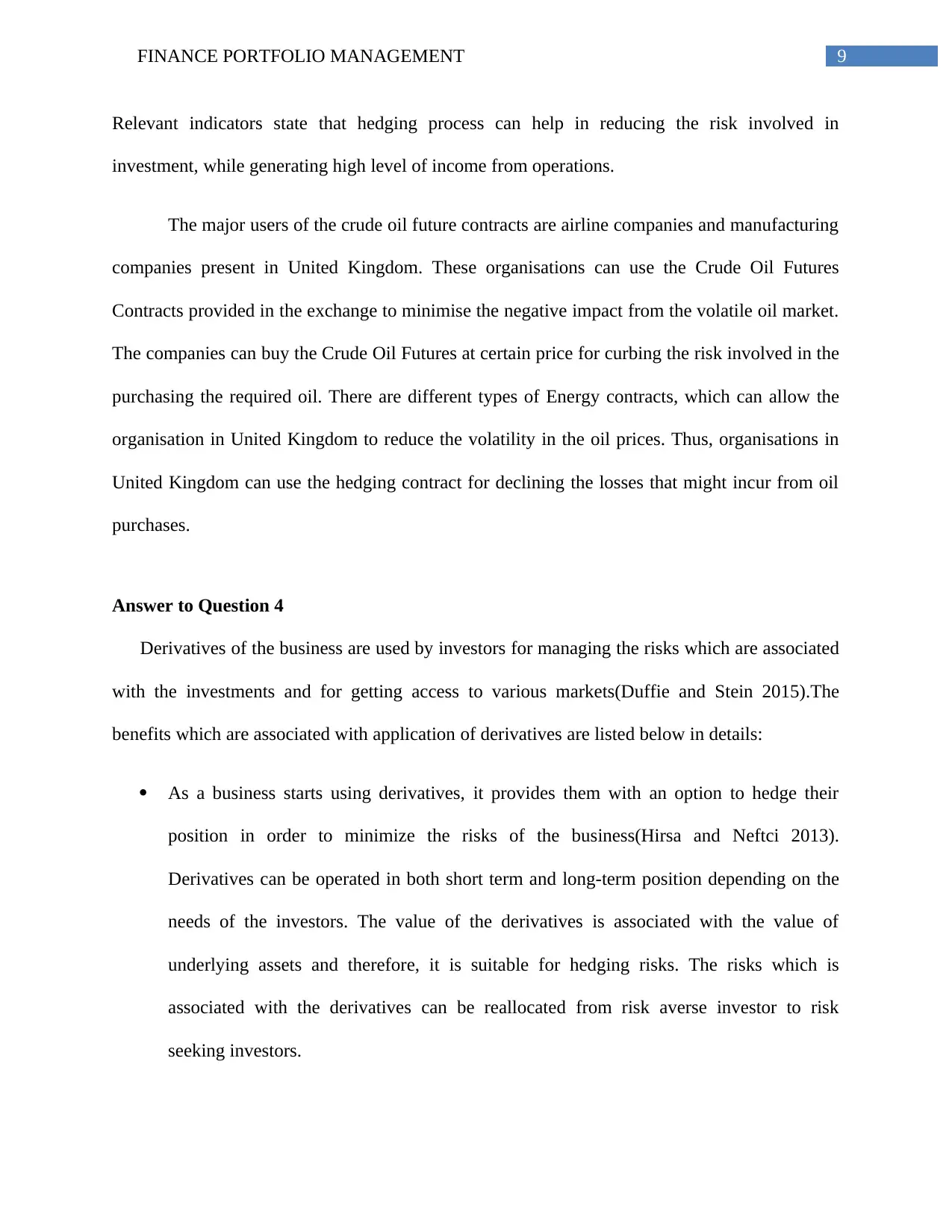
9FINANCE PORTFOLIO MANAGEMENT
Relevant indicators state that hedging process can help in reducing the risk involved in
investment, while generating high level of income from operations.
The major users of the crude oil future contracts are airline companies and manufacturing
companies present in United Kingdom. These organisations can use the Crude Oil Futures
Contracts provided in the exchange to minimise the negative impact from the volatile oil market.
The companies can buy the Crude Oil Futures at certain price for curbing the risk involved in the
purchasing the required oil. There are different types of Energy contracts, which can allow the
organisation in United Kingdom to reduce the volatility in the oil prices. Thus, organisations in
United Kingdom can use the hedging contract for declining the losses that might incur from oil
purchases.
Answer to Question 4
Derivatives of the business are used by investors for managing the risks which are associated
with the investments and for getting access to various markets(Duffie and Stein 2015).The
benefits which are associated with application of derivatives are listed below in details:
As a business starts using derivatives, it provides them with an option to hedge their
position in order to minimize the risks of the business(Hirsa and Neftci 2013).
Derivatives can be operated in both short term and long-term position depending on the
needs of the investors. The value of the derivatives is associated with the value of
underlying assets and therefore, it is suitable for hedging risks. The risks which is
associated with the derivatives can be reallocated from risk averse investor to risk
seeking investors.
Relevant indicators state that hedging process can help in reducing the risk involved in
investment, while generating high level of income from operations.
The major users of the crude oil future contracts are airline companies and manufacturing
companies present in United Kingdom. These organisations can use the Crude Oil Futures
Contracts provided in the exchange to minimise the negative impact from the volatile oil market.
The companies can buy the Crude Oil Futures at certain price for curbing the risk involved in the
purchasing the required oil. There are different types of Energy contracts, which can allow the
organisation in United Kingdom to reduce the volatility in the oil prices. Thus, organisations in
United Kingdom can use the hedging contract for declining the losses that might incur from oil
purchases.
Answer to Question 4
Derivatives of the business are used by investors for managing the risks which are associated
with the investments and for getting access to various markets(Duffie and Stein 2015).The
benefits which are associated with application of derivatives are listed below in details:
As a business starts using derivatives, it provides them with an option to hedge their
position in order to minimize the risks of the business(Hirsa and Neftci 2013).
Derivatives can be operated in both short term and long-term position depending on the
needs of the investors. The value of the derivatives is associated with the value of
underlying assets and therefore, it is suitable for hedging risks. The risks which is
associated with the derivatives can be reallocated from risk averse investor to risk
seeking investors.
Secure Best Marks with AI Grader
Need help grading? Try our AI Grader for instant feedback on your assignments.
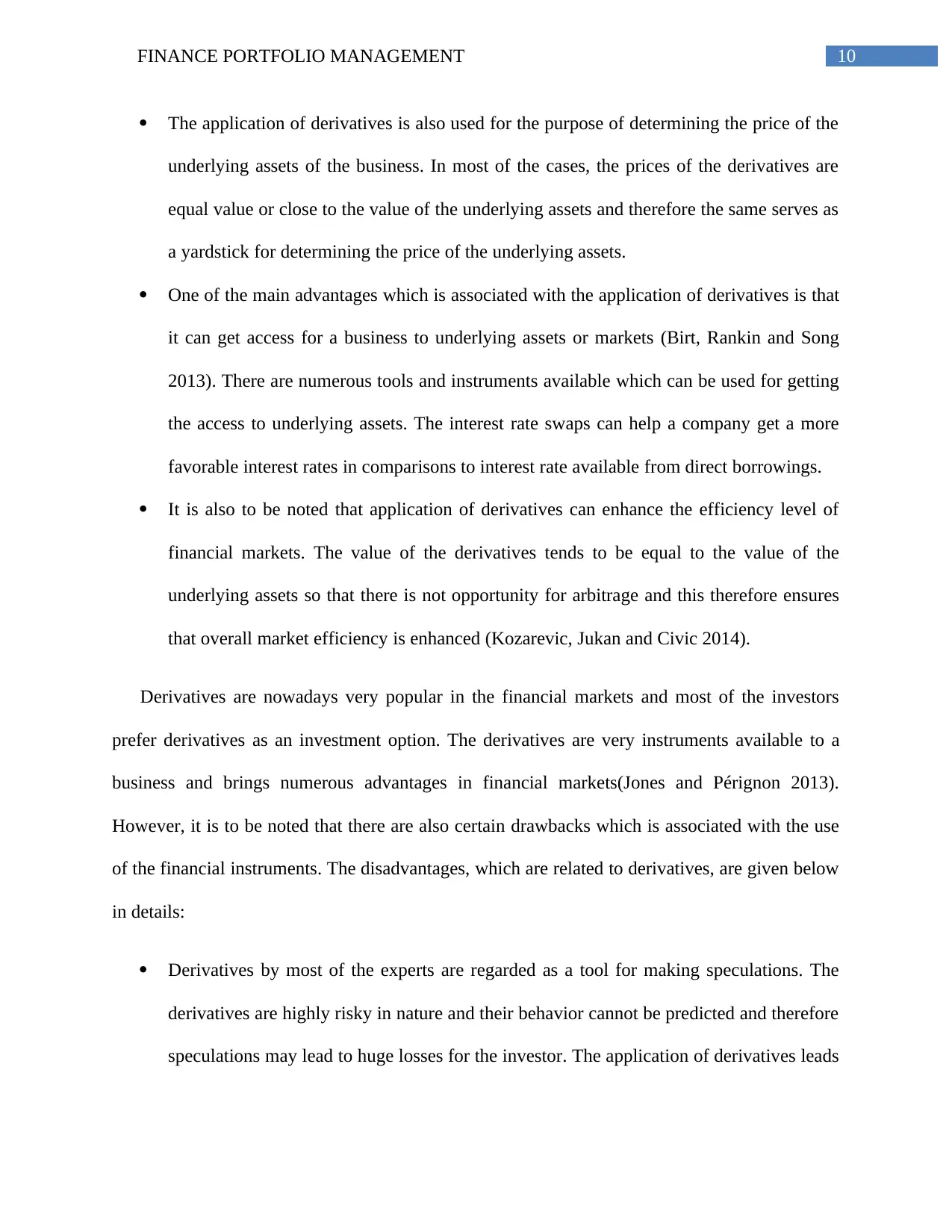
10FINANCE PORTFOLIO MANAGEMENT
The application of derivatives is also used for the purpose of determining the price of the
underlying assets of the business. In most of the cases, the prices of the derivatives are
equal value or close to the value of the underlying assets and therefore the same serves as
a yardstick for determining the price of the underlying assets.
One of the main advantages which is associated with the application of derivatives is that
it can get access for a business to underlying assets or markets (Birt, Rankin and Song
2013). There are numerous tools and instruments available which can be used for getting
the access to underlying assets. The interest rate swaps can help a company get a more
favorable interest rates in comparisons to interest rate available from direct borrowings.
It is also to be noted that application of derivatives can enhance the efficiency level of
financial markets. The value of the derivatives tends to be equal to the value of the
underlying assets so that there is not opportunity for arbitrage and this therefore ensures
that overall market efficiency is enhanced (Kozarevic, Jukan and Civic 2014).
Derivatives are nowadays very popular in the financial markets and most of the investors
prefer derivatives as an investment option. The derivatives are very instruments available to a
business and brings numerous advantages in financial markets(Jones and Pérignon 2013).
However, it is to be noted that there are also certain drawbacks which is associated with the use
of the financial instruments. The disadvantages, which are related to derivatives, are given below
in details:
Derivatives by most of the experts are regarded as a tool for making speculations. The
derivatives are highly risky in nature and their behavior cannot be predicted and therefore
speculations may lead to huge losses for the investor. The application of derivatives leads
The application of derivatives is also used for the purpose of determining the price of the
underlying assets of the business. In most of the cases, the prices of the derivatives are
equal value or close to the value of the underlying assets and therefore the same serves as
a yardstick for determining the price of the underlying assets.
One of the main advantages which is associated with the application of derivatives is that
it can get access for a business to underlying assets or markets (Birt, Rankin and Song
2013). There are numerous tools and instruments available which can be used for getting
the access to underlying assets. The interest rate swaps can help a company get a more
favorable interest rates in comparisons to interest rate available from direct borrowings.
It is also to be noted that application of derivatives can enhance the efficiency level of
financial markets. The value of the derivatives tends to be equal to the value of the
underlying assets so that there is not opportunity for arbitrage and this therefore ensures
that overall market efficiency is enhanced (Kozarevic, Jukan and Civic 2014).
Derivatives are nowadays very popular in the financial markets and most of the investors
prefer derivatives as an investment option. The derivatives are very instruments available to a
business and brings numerous advantages in financial markets(Jones and Pérignon 2013).
However, it is to be noted that there are also certain drawbacks which is associated with the use
of the financial instruments. The disadvantages, which are related to derivatives, are given below
in details:
Derivatives by most of the experts are regarded as a tool for making speculations. The
derivatives are highly risky in nature and their behavior cannot be predicted and therefore
speculations may lead to huge losses for the investor. The application of derivatives leads
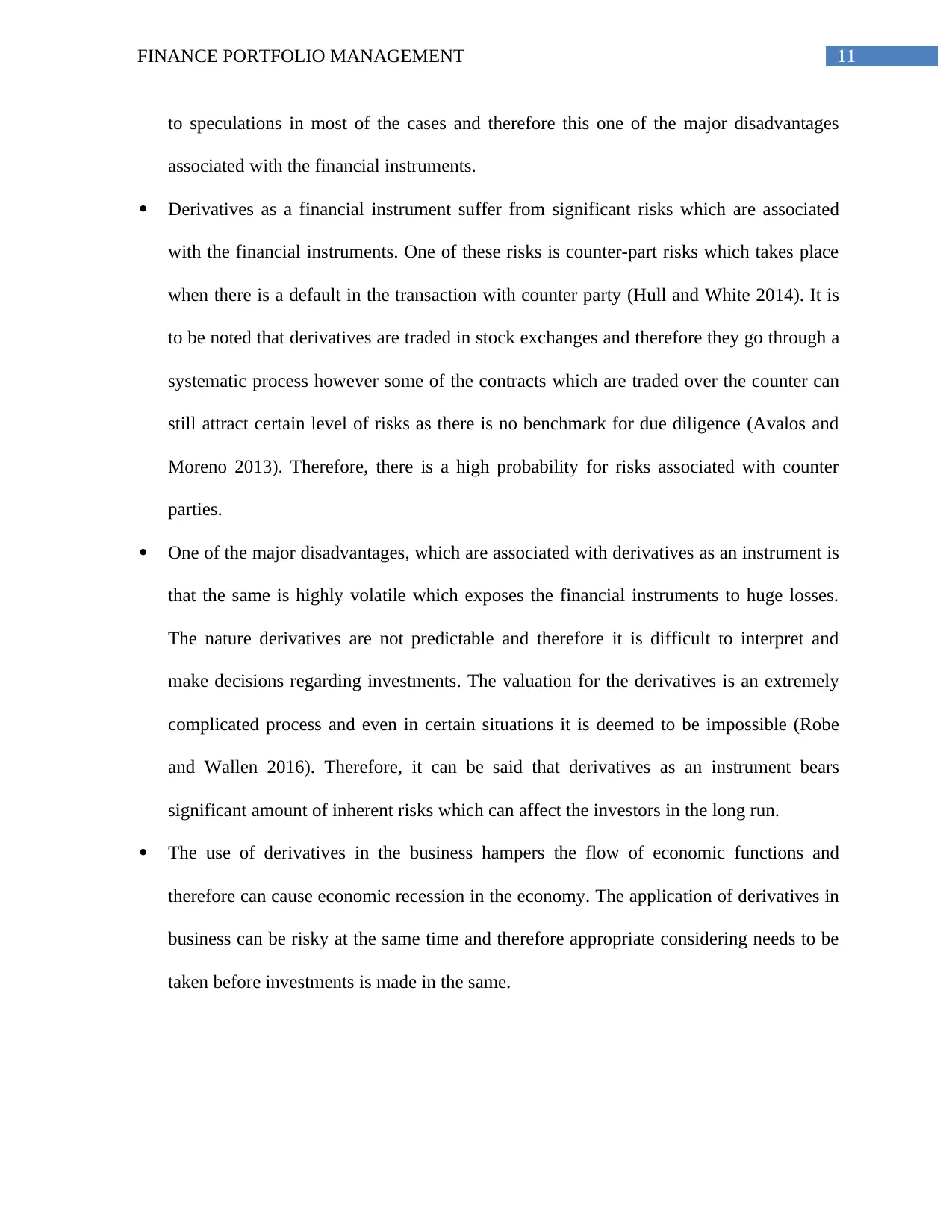
11FINANCE PORTFOLIO MANAGEMENT
to speculations in most of the cases and therefore this one of the major disadvantages
associated with the financial instruments.
Derivatives as a financial instrument suffer from significant risks which are associated
with the financial instruments. One of these risks is counter-part risks which takes place
when there is a default in the transaction with counter party (Hull and White 2014). It is
to be noted that derivatives are traded in stock exchanges and therefore they go through a
systematic process however some of the contracts which are traded over the counter can
still attract certain level of risks as there is no benchmark for due diligence (Avalos and
Moreno 2013). Therefore, there is a high probability for risks associated with counter
parties.
One of the major disadvantages, which are associated with derivatives as an instrument is
that the same is highly volatile which exposes the financial instruments to huge losses.
The nature derivatives are not predictable and therefore it is difficult to interpret and
make decisions regarding investments. The valuation for the derivatives is an extremely
complicated process and even in certain situations it is deemed to be impossible (Robe
and Wallen 2016). Therefore, it can be said that derivatives as an instrument bears
significant amount of inherent risks which can affect the investors in the long run.
The use of derivatives in the business hampers the flow of economic functions and
therefore can cause economic recession in the economy. The application of derivatives in
business can be risky at the same time and therefore appropriate considering needs to be
taken before investments is made in the same.
to speculations in most of the cases and therefore this one of the major disadvantages
associated with the financial instruments.
Derivatives as a financial instrument suffer from significant risks which are associated
with the financial instruments. One of these risks is counter-part risks which takes place
when there is a default in the transaction with counter party (Hull and White 2014). It is
to be noted that derivatives are traded in stock exchanges and therefore they go through a
systematic process however some of the contracts which are traded over the counter can
still attract certain level of risks as there is no benchmark for due diligence (Avalos and
Moreno 2013). Therefore, there is a high probability for risks associated with counter
parties.
One of the major disadvantages, which are associated with derivatives as an instrument is
that the same is highly volatile which exposes the financial instruments to huge losses.
The nature derivatives are not predictable and therefore it is difficult to interpret and
make decisions regarding investments. The valuation for the derivatives is an extremely
complicated process and even in certain situations it is deemed to be impossible (Robe
and Wallen 2016). Therefore, it can be said that derivatives as an instrument bears
significant amount of inherent risks which can affect the investors in the long run.
The use of derivatives in the business hampers the flow of economic functions and
therefore can cause economic recession in the economy. The application of derivatives in
business can be risky at the same time and therefore appropriate considering needs to be
taken before investments is made in the same.
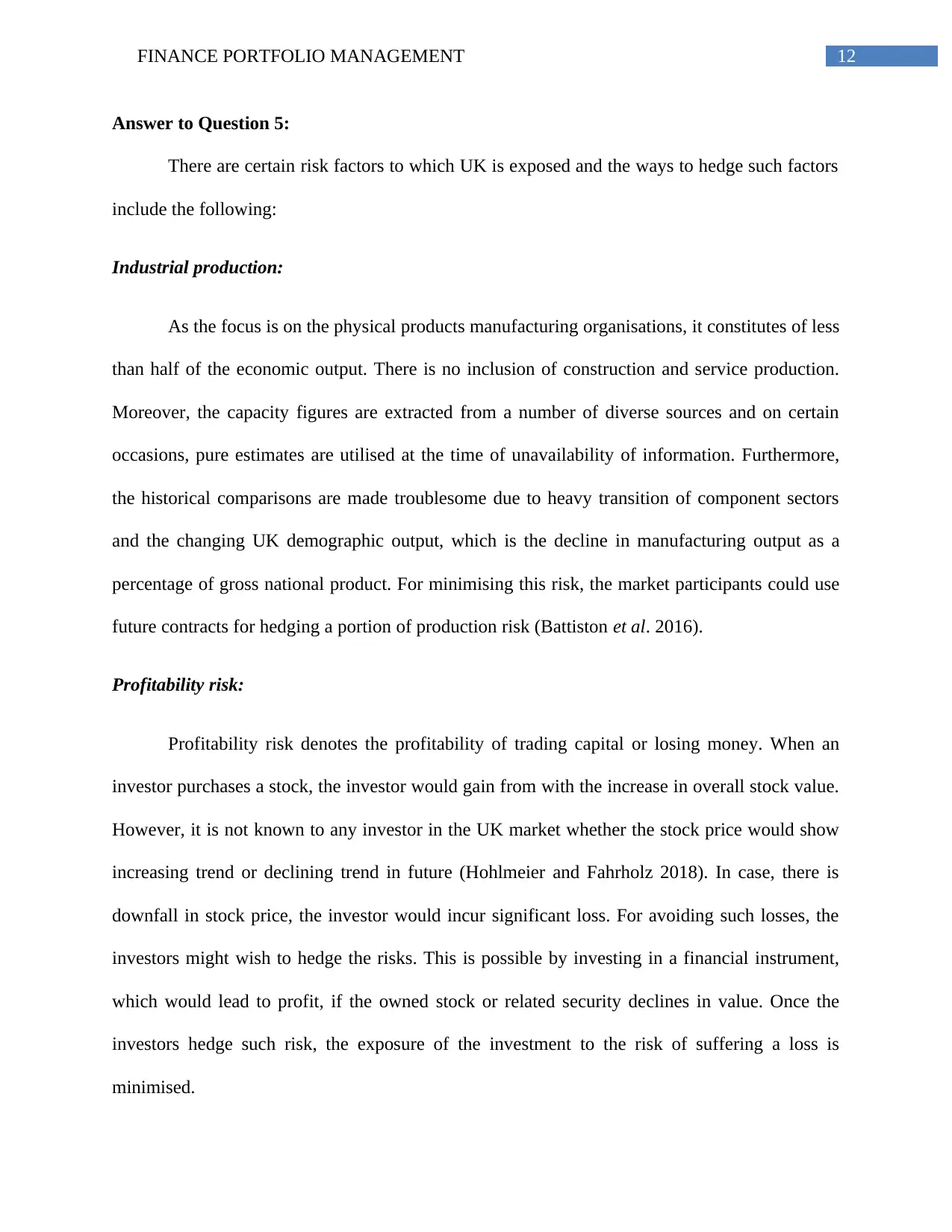
12FINANCE PORTFOLIO MANAGEMENT
Answer to Question 5:
There are certain risk factors to which UK is exposed and the ways to hedge such factors
include the following:
Industrial production:
As the focus is on the physical products manufacturing organisations, it constitutes of less
than half of the economic output. There is no inclusion of construction and service production.
Moreover, the capacity figures are extracted from a number of diverse sources and on certain
occasions, pure estimates are utilised at the time of unavailability of information. Furthermore,
the historical comparisons are made troublesome due to heavy transition of component sectors
and the changing UK demographic output, which is the decline in manufacturing output as a
percentage of gross national product. For minimising this risk, the market participants could use
future contracts for hedging a portion of production risk (Battiston et al. 2016).
Profitability risk:
Profitability risk denotes the profitability of trading capital or losing money. When an
investor purchases a stock, the investor would gain from with the increase in overall stock value.
However, it is not known to any investor in the UK market whether the stock price would show
increasing trend or declining trend in future (Hohlmeier and Fahrholz 2018). In case, there is
downfall in stock price, the investor would incur significant loss. For avoiding such losses, the
investors might wish to hedge the risks. This is possible by investing in a financial instrument,
which would lead to profit, if the owned stock or related security declines in value. Once the
investors hedge such risk, the exposure of the investment to the risk of suffering a loss is
minimised.
Answer to Question 5:
There are certain risk factors to which UK is exposed and the ways to hedge such factors
include the following:
Industrial production:
As the focus is on the physical products manufacturing organisations, it constitutes of less
than half of the economic output. There is no inclusion of construction and service production.
Moreover, the capacity figures are extracted from a number of diverse sources and on certain
occasions, pure estimates are utilised at the time of unavailability of information. Furthermore,
the historical comparisons are made troublesome due to heavy transition of component sectors
and the changing UK demographic output, which is the decline in manufacturing output as a
percentage of gross national product. For minimising this risk, the market participants could use
future contracts for hedging a portion of production risk (Battiston et al. 2016).
Profitability risk:
Profitability risk denotes the profitability of trading capital or losing money. When an
investor purchases a stock, the investor would gain from with the increase in overall stock value.
However, it is not known to any investor in the UK market whether the stock price would show
increasing trend or declining trend in future (Hohlmeier and Fahrholz 2018). In case, there is
downfall in stock price, the investor would incur significant loss. For avoiding such losses, the
investors might wish to hedge the risks. This is possible by investing in a financial instrument,
which would lead to profit, if the owned stock or related security declines in value. Once the
investors hedge such risk, the exposure of the investment to the risk of suffering a loss is
minimised.
Paraphrase This Document
Need a fresh take? Get an instant paraphrase of this document with our AI Paraphraser
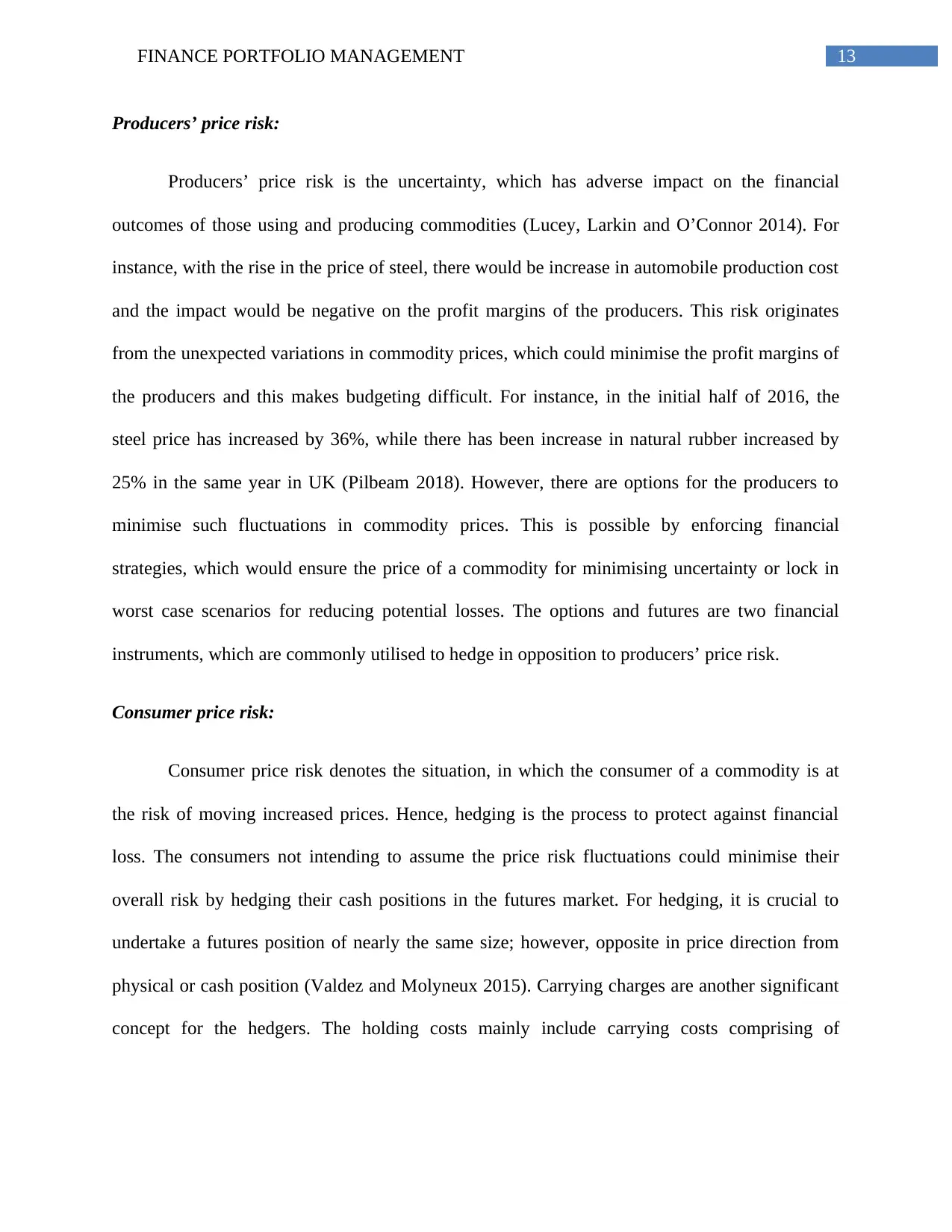
13FINANCE PORTFOLIO MANAGEMENT
Producers’ price risk:
Producers’ price risk is the uncertainty, which has adverse impact on the financial
outcomes of those using and producing commodities (Lucey, Larkin and O’Connor 2014). For
instance, with the rise in the price of steel, there would be increase in automobile production cost
and the impact would be negative on the profit margins of the producers. This risk originates
from the unexpected variations in commodity prices, which could minimise the profit margins of
the producers and this makes budgeting difficult. For instance, in the initial half of 2016, the
steel price has increased by 36%, while there has been increase in natural rubber increased by
25% in the same year in UK (Pilbeam 2018). However, there are options for the producers to
minimise such fluctuations in commodity prices. This is possible by enforcing financial
strategies, which would ensure the price of a commodity for minimising uncertainty or lock in
worst case scenarios for reducing potential losses. The options and futures are two financial
instruments, which are commonly utilised to hedge in opposition to producers’ price risk.
Consumer price risk:
Consumer price risk denotes the situation, in which the consumer of a commodity is at
the risk of moving increased prices. Hence, hedging is the process to protect against financial
loss. The consumers not intending to assume the price risk fluctuations could minimise their
overall risk by hedging their cash positions in the futures market. For hedging, it is crucial to
undertake a futures position of nearly the same size; however, opposite in price direction from
physical or cash position (Valdez and Molyneux 2015). Carrying charges are another significant
concept for the hedgers. The holding costs mainly include carrying costs comprising of
Producers’ price risk:
Producers’ price risk is the uncertainty, which has adverse impact on the financial
outcomes of those using and producing commodities (Lucey, Larkin and O’Connor 2014). For
instance, with the rise in the price of steel, there would be increase in automobile production cost
and the impact would be negative on the profit margins of the producers. This risk originates
from the unexpected variations in commodity prices, which could minimise the profit margins of
the producers and this makes budgeting difficult. For instance, in the initial half of 2016, the
steel price has increased by 36%, while there has been increase in natural rubber increased by
25% in the same year in UK (Pilbeam 2018). However, there are options for the producers to
minimise such fluctuations in commodity prices. This is possible by enforcing financial
strategies, which would ensure the price of a commodity for minimising uncertainty or lock in
worst case scenarios for reducing potential losses. The options and futures are two financial
instruments, which are commonly utilised to hedge in opposition to producers’ price risk.
Consumer price risk:
Consumer price risk denotes the situation, in which the consumer of a commodity is at
the risk of moving increased prices. Hence, hedging is the process to protect against financial
loss. The consumers not intending to assume the price risk fluctuations could minimise their
overall risk by hedging their cash positions in the futures market. For hedging, it is crucial to
undertake a futures position of nearly the same size; however, opposite in price direction from
physical or cash position (Valdez and Molyneux 2015). Carrying charges are another significant
concept for the hedgers. The holding costs mainly include carrying costs comprising of
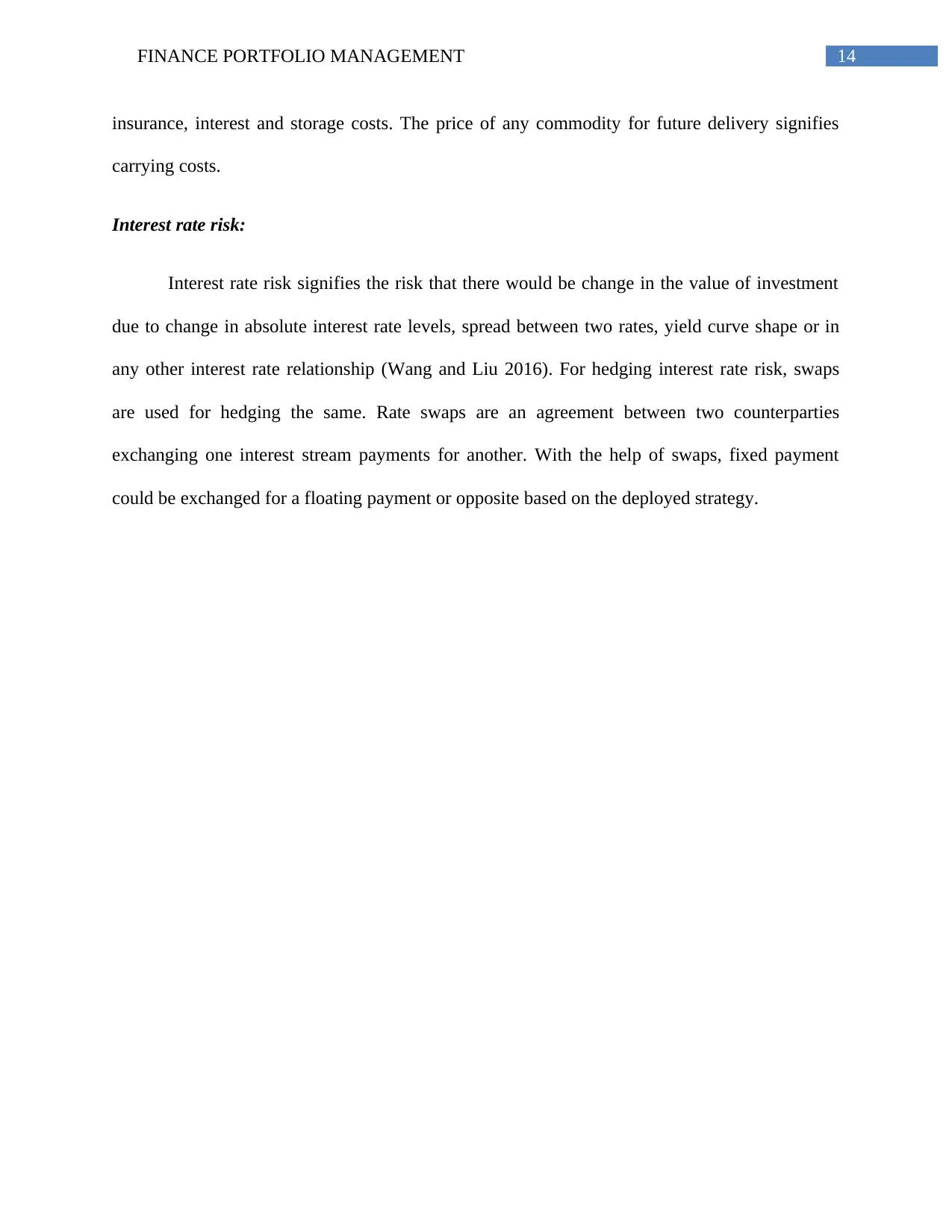
14FINANCE PORTFOLIO MANAGEMENT
insurance, interest and storage costs. The price of any commodity for future delivery signifies
carrying costs.
Interest rate risk:
Interest rate risk signifies the risk that there would be change in the value of investment
due to change in absolute interest rate levels, spread between two rates, yield curve shape or in
any other interest rate relationship (Wang and Liu 2016). For hedging interest rate risk, swaps
are used for hedging the same. Rate swaps are an agreement between two counterparties
exchanging one interest stream payments for another. With the help of swaps, fixed payment
could be exchanged for a floating payment or opposite based on the deployed strategy.
insurance, interest and storage costs. The price of any commodity for future delivery signifies
carrying costs.
Interest rate risk:
Interest rate risk signifies the risk that there would be change in the value of investment
due to change in absolute interest rate levels, spread between two rates, yield curve shape or in
any other interest rate relationship (Wang and Liu 2016). For hedging interest rate risk, swaps
are used for hedging the same. Rate swaps are an agreement between two counterparties
exchanging one interest stream payments for another. With the help of swaps, fixed payment
could be exchanged for a floating payment or opposite based on the deployed strategy.
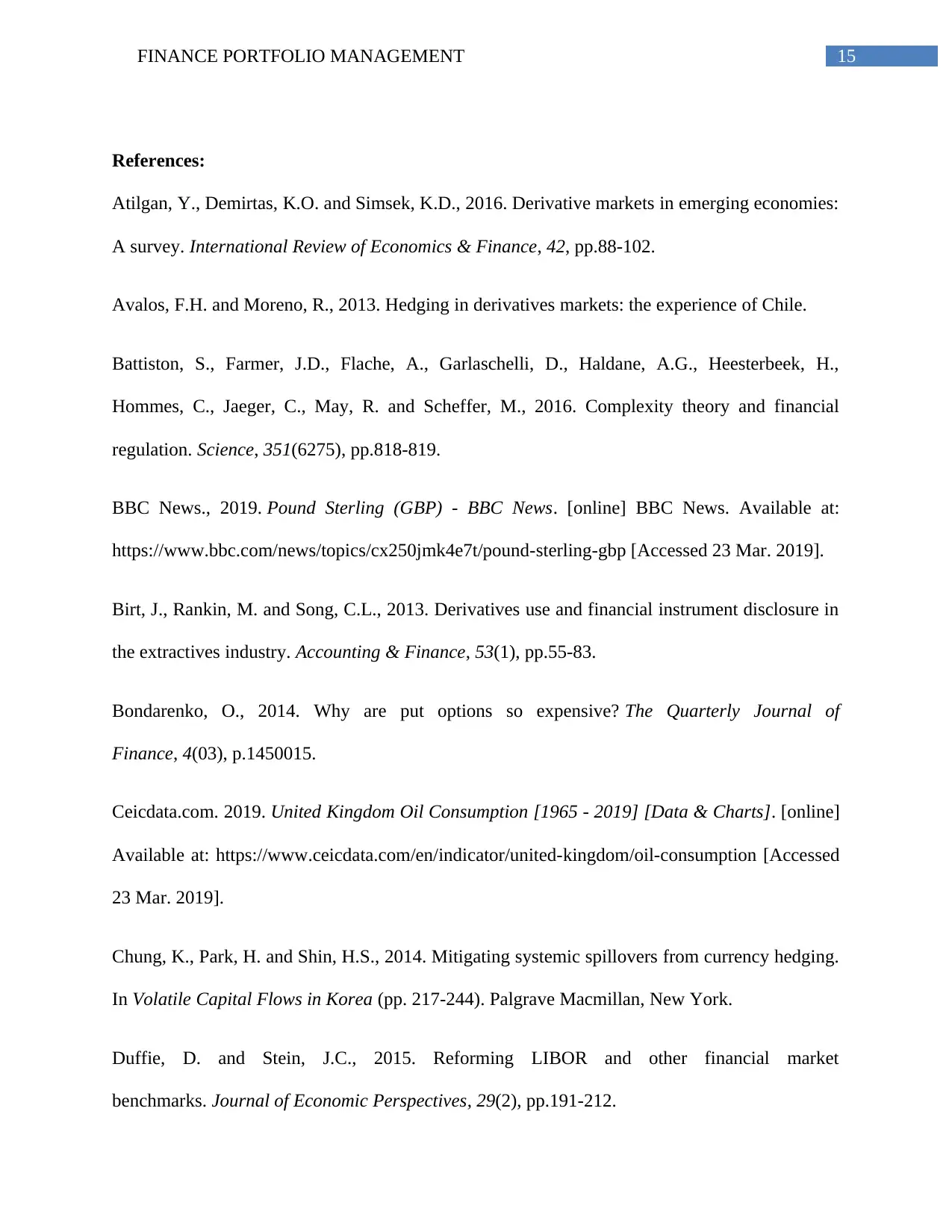
15FINANCE PORTFOLIO MANAGEMENT
References:
Atilgan, Y., Demirtas, K.O. and Simsek, K.D., 2016. Derivative markets in emerging economies:
A survey. International Review of Economics & Finance, 42, pp.88-102.
Avalos, F.H. and Moreno, R., 2013. Hedging in derivatives markets: the experience of Chile.
Battiston, S., Farmer, J.D., Flache, A., Garlaschelli, D., Haldane, A.G., Heesterbeek, H.,
Hommes, C., Jaeger, C., May, R. and Scheffer, M., 2016. Complexity theory and financial
regulation. Science, 351(6275), pp.818-819.
BBC News., 2019. Pound Sterling (GBP) - BBC News. [online] BBC News. Available at:
https://www.bbc.com/news/topics/cx250jmk4e7t/pound-sterling-gbp [Accessed 23 Mar. 2019].
Birt, J., Rankin, M. and Song, C.L., 2013. Derivatives use and financial instrument disclosure in
the extractives industry. Accounting & Finance, 53(1), pp.55-83.
Bondarenko, O., 2014. Why are put options so expensive? The Quarterly Journal of
Finance, 4(03), p.1450015.
Ceicdata.com. 2019. United Kingdom Oil Consumption [1965 - 2019] [Data & Charts]. [online]
Available at: https://www.ceicdata.com/en/indicator/united-kingdom/oil-consumption [Accessed
23 Mar. 2019].
Chung, K., Park, H. and Shin, H.S., 2014. Mitigating systemic spillovers from currency hedging.
In Volatile Capital Flows in Korea (pp. 217-244). Palgrave Macmillan, New York.
Duffie, D. and Stein, J.C., 2015. Reforming LIBOR and other financial market
benchmarks. Journal of Economic Perspectives, 29(2), pp.191-212.
References:
Atilgan, Y., Demirtas, K.O. and Simsek, K.D., 2016. Derivative markets in emerging economies:
A survey. International Review of Economics & Finance, 42, pp.88-102.
Avalos, F.H. and Moreno, R., 2013. Hedging in derivatives markets: the experience of Chile.
Battiston, S., Farmer, J.D., Flache, A., Garlaschelli, D., Haldane, A.G., Heesterbeek, H.,
Hommes, C., Jaeger, C., May, R. and Scheffer, M., 2016. Complexity theory and financial
regulation. Science, 351(6275), pp.818-819.
BBC News., 2019. Pound Sterling (GBP) - BBC News. [online] BBC News. Available at:
https://www.bbc.com/news/topics/cx250jmk4e7t/pound-sterling-gbp [Accessed 23 Mar. 2019].
Birt, J., Rankin, M. and Song, C.L., 2013. Derivatives use and financial instrument disclosure in
the extractives industry. Accounting & Finance, 53(1), pp.55-83.
Bondarenko, O., 2014. Why are put options so expensive? The Quarterly Journal of
Finance, 4(03), p.1450015.
Ceicdata.com. 2019. United Kingdom Oil Consumption [1965 - 2019] [Data & Charts]. [online]
Available at: https://www.ceicdata.com/en/indicator/united-kingdom/oil-consumption [Accessed
23 Mar. 2019].
Chung, K., Park, H. and Shin, H.S., 2014. Mitigating systemic spillovers from currency hedging.
In Volatile Capital Flows in Korea (pp. 217-244). Palgrave Macmillan, New York.
Duffie, D. and Stein, J.C., 2015. Reforming LIBOR and other financial market
benchmarks. Journal of Economic Perspectives, 29(2), pp.191-212.
Secure Best Marks with AI Grader
Need help grading? Try our AI Grader for instant feedback on your assignments.
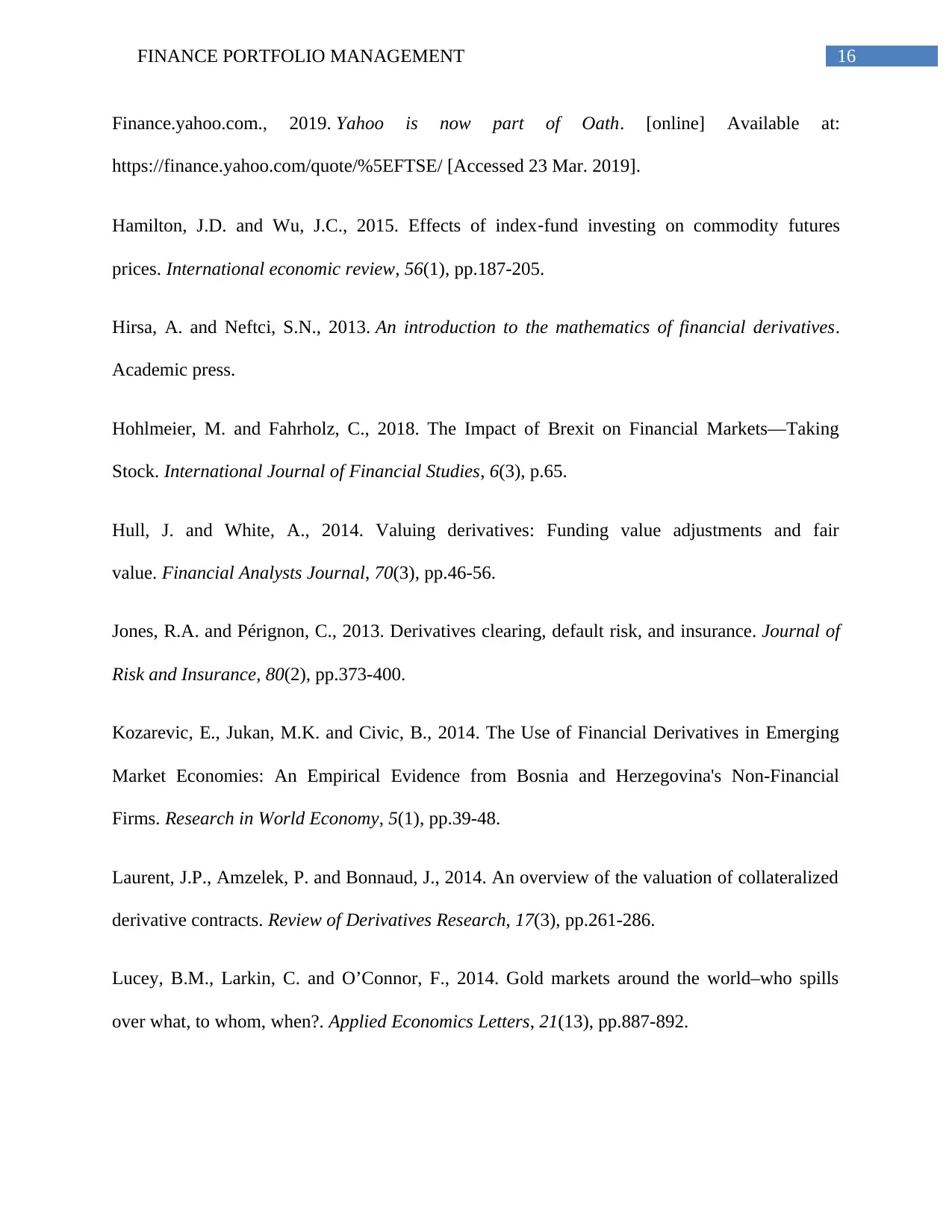
16FINANCE PORTFOLIO MANAGEMENT
Finance.yahoo.com., 2019. Yahoo is now part of Oath. [online] Available at:
https://finance.yahoo.com/quote/%5EFTSE/ [Accessed 23 Mar. 2019].
Hamilton, J.D. and Wu, J.C., 2015. Effects of index‐fund investing on commodity futures
prices. International economic review, 56(1), pp.187-205.
Hirsa, A. and Neftci, S.N., 2013. An introduction to the mathematics of financial derivatives.
Academic press.
Hohlmeier, M. and Fahrholz, C., 2018. The Impact of Brexit on Financial Markets—Taking
Stock. International Journal of Financial Studies, 6(3), p.65.
Hull, J. and White, A., 2014. Valuing derivatives: Funding value adjustments and fair
value. Financial Analysts Journal, 70(3), pp.46-56.
Jones, R.A. and Pérignon, C., 2013. Derivatives clearing, default risk, and insurance. Journal of
Risk and Insurance, 80(2), pp.373-400.
Kozarevic, E., Jukan, M.K. and Civic, B., 2014. The Use of Financial Derivatives in Emerging
Market Economies: An Empirical Evidence from Bosnia and Herzegovina's Non-Financial
Firms. Research in World Economy, 5(1), pp.39-48.
Laurent, J.P., Amzelek, P. and Bonnaud, J., 2014. An overview of the valuation of collateralized
derivative contracts. Review of Derivatives Research, 17(3), pp.261-286.
Lucey, B.M., Larkin, C. and O’Connor, F., 2014. Gold markets around the world–who spills
over what, to whom, when?. Applied Economics Letters, 21(13), pp.887-892.
Finance.yahoo.com., 2019. Yahoo is now part of Oath. [online] Available at:
https://finance.yahoo.com/quote/%5EFTSE/ [Accessed 23 Mar. 2019].
Hamilton, J.D. and Wu, J.C., 2015. Effects of index‐fund investing on commodity futures
prices. International economic review, 56(1), pp.187-205.
Hirsa, A. and Neftci, S.N., 2013. An introduction to the mathematics of financial derivatives.
Academic press.
Hohlmeier, M. and Fahrholz, C., 2018. The Impact of Brexit on Financial Markets—Taking
Stock. International Journal of Financial Studies, 6(3), p.65.
Hull, J. and White, A., 2014. Valuing derivatives: Funding value adjustments and fair
value. Financial Analysts Journal, 70(3), pp.46-56.
Jones, R.A. and Pérignon, C., 2013. Derivatives clearing, default risk, and insurance. Journal of
Risk and Insurance, 80(2), pp.373-400.
Kozarevic, E., Jukan, M.K. and Civic, B., 2014. The Use of Financial Derivatives in Emerging
Market Economies: An Empirical Evidence from Bosnia and Herzegovina's Non-Financial
Firms. Research in World Economy, 5(1), pp.39-48.
Laurent, J.P., Amzelek, P. and Bonnaud, J., 2014. An overview of the valuation of collateralized
derivative contracts. Review of Derivatives Research, 17(3), pp.261-286.
Lucey, B.M., Larkin, C. and O’Connor, F., 2014. Gold markets around the world–who spills
over what, to whom, when?. Applied Economics Letters, 21(13), pp.887-892.
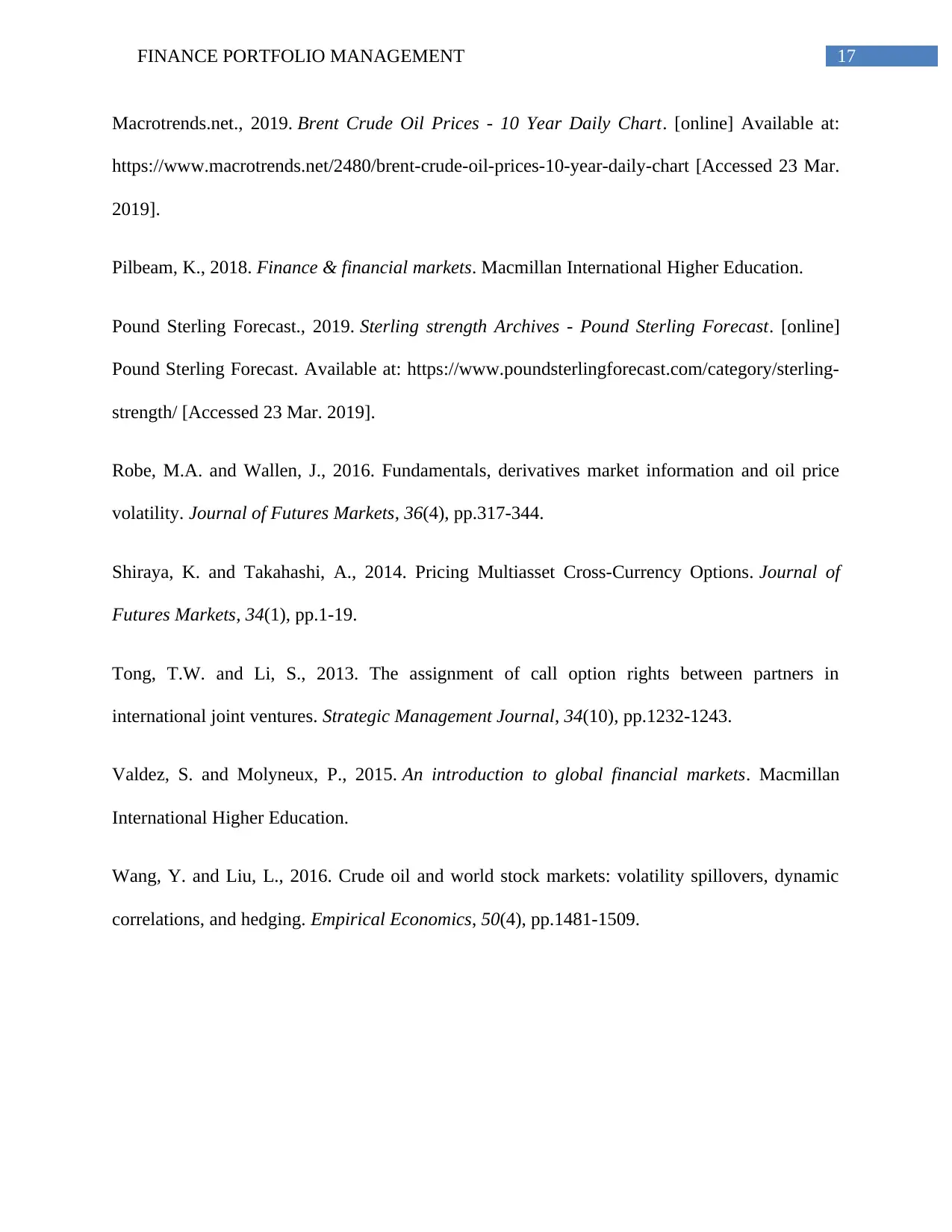
17FINANCE PORTFOLIO MANAGEMENT
Macrotrends.net., 2019. Brent Crude Oil Prices - 10 Year Daily Chart. [online] Available at:
https://www.macrotrends.net/2480/brent-crude-oil-prices-10-year-daily-chart [Accessed 23 Mar.
2019].
Pilbeam, K., 2018. Finance & financial markets. Macmillan International Higher Education.
Pound Sterling Forecast., 2019. Sterling strength Archives - Pound Sterling Forecast. [online]
Pound Sterling Forecast. Available at: https://www.poundsterlingforecast.com/category/sterling-
strength/ [Accessed 23 Mar. 2019].
Robe, M.A. and Wallen, J., 2016. Fundamentals, derivatives market information and oil price
volatility. Journal of Futures Markets, 36(4), pp.317-344.
Shiraya, K. and Takahashi, A., 2014. Pricing Multiasset Cross‐Currency Options. Journal of
Futures Markets, 34(1), pp.1-19.
Tong, T.W. and Li, S., 2013. The assignment of call option rights between partners in
international joint ventures. Strategic Management Journal, 34(10), pp.1232-1243.
Valdez, S. and Molyneux, P., 2015. An introduction to global financial markets. Macmillan
International Higher Education.
Wang, Y. and Liu, L., 2016. Crude oil and world stock markets: volatility spillovers, dynamic
correlations, and hedging. Empirical Economics, 50(4), pp.1481-1509.
Macrotrends.net., 2019. Brent Crude Oil Prices - 10 Year Daily Chart. [online] Available at:
https://www.macrotrends.net/2480/brent-crude-oil-prices-10-year-daily-chart [Accessed 23 Mar.
2019].
Pilbeam, K., 2018. Finance & financial markets. Macmillan International Higher Education.
Pound Sterling Forecast., 2019. Sterling strength Archives - Pound Sterling Forecast. [online]
Pound Sterling Forecast. Available at: https://www.poundsterlingforecast.com/category/sterling-
strength/ [Accessed 23 Mar. 2019].
Robe, M.A. and Wallen, J., 2016. Fundamentals, derivatives market information and oil price
volatility. Journal of Futures Markets, 36(4), pp.317-344.
Shiraya, K. and Takahashi, A., 2014. Pricing Multiasset Cross‐Currency Options. Journal of
Futures Markets, 34(1), pp.1-19.
Tong, T.W. and Li, S., 2013. The assignment of call option rights between partners in
international joint ventures. Strategic Management Journal, 34(10), pp.1232-1243.
Valdez, S. and Molyneux, P., 2015. An introduction to global financial markets. Macmillan
International Higher Education.
Wang, Y. and Liu, L., 2016. Crude oil and world stock markets: volatility spillovers, dynamic
correlations, and hedging. Empirical Economics, 50(4), pp.1481-1509.

18FINANCE PORTFOLIO MANAGEMENT
1 out of 19
Your All-in-One AI-Powered Toolkit for Academic Success.
+13062052269
info@desklib.com
Available 24*7 on WhatsApp / Email
![[object Object]](/_next/static/media/star-bottom.7253800d.svg)
Unlock your academic potential
© 2024 | Zucol Services PVT LTD | All rights reserved.





